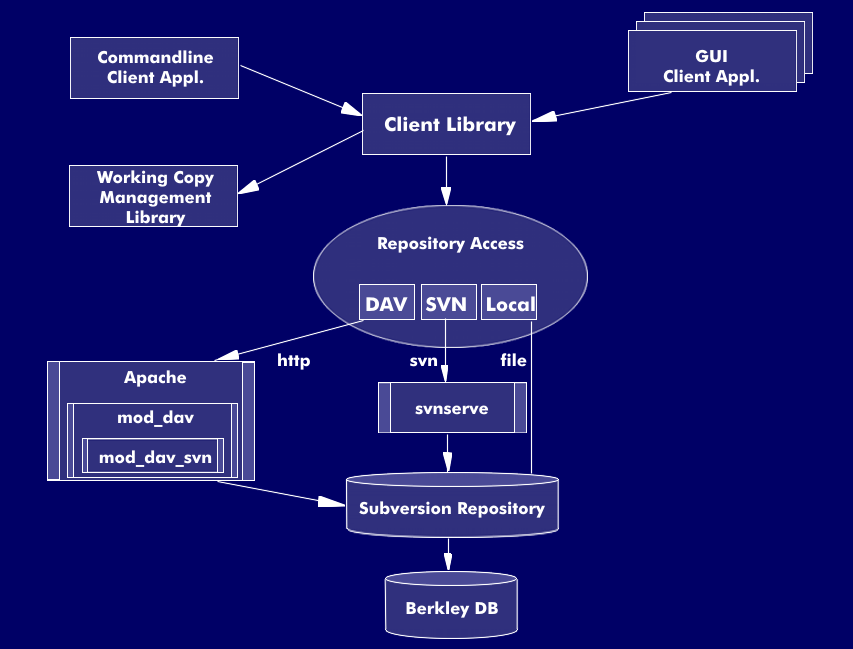subversion
Subversion is next to Concurrent Version System(CVS) probably the best known freely available version control system. The software is available in January 2010 in version 1.6.6 at the link below. The general task of version control systems is to record changes to data over time.
Subversion is developed since beginning of 2000 by CollabNet Inc. and is thereby no advancement of CVS, but a complete new development on basis of the fundamental idea of CVS, without taking over its conceptional weaknesses. With this development Subversion arranges itself - far beyond the abilities of CVS - into the row of commercial competitors such as Perforce and ClearCase. On basis of the Programming Application Interfaces( API) third manufacturers can develop own products as for example for the integration of Subversion into an interface like the K-Desktop-Environment( KDE)( Linux: kdesvn) or a development environment like Dreamweaver (Adobe Systems: CS4).
Subversion as a client-server architecture
The figure shows the basic structure of Subversion, which realizes a client- server architecture. Thus Subversion is applicable in particular also for distributed projects. Due to its good scaling Subversion can be used independently of the size of a project. On the local systems of the team members the Subversion client svn is installed in each case. The client takes care of the communication with the Subversion repository and processes the working copies provided to it in its local workspace. Subversion is operated via the command line, a corresponding Graphical User Interface( GUI) or via an integrated development environment such as a special Eclipse plug-in(Subversive). Subversion supports several server variants - the stand-alone server svnserve and the module mod_dav_svn for the Apache web server - and various communication protocols.
A repository is the basic core of Subversion and stores all information about the individual files and directories of a project. The repository is centrally managed and stores the data in hierarchical directory trees. In doing so, each directory tree has a unique revision number and thus represents a snapshot of the repository.
Some important features of Subversion are:
- Files and directories are versioned for a complete version history,
- File conflicts are resolved interactively,
- Semi-automatic branch and merge tracking,
- Client-side changelist management, so a Subversion client doesn't have to rely on a constant connection to the repository,
- Efficient delta creation algorithm, only changes are stored in the process,
- Equal treatment of text and binary data,
- Transaction-driven transfer of data to the repository according to ACID paradigms,
- Powerful branching - the branching into variants - and tagging - the naming of file versions ,
- A strong syntax for external definitions,
- SASL authentication support for the svnserve server.
A brief description of the components of Subversion. Except for the svn component, all other programs are used to monitor or administer Subversion.
svn: Command line oriented program for working with Subversion.
svnversion: Shows the status of the local working copy.
svnlook: Used to display the contents of a Subversion repository.
svnadmin: Used to administer Subversion.
mod_dav_svn: Module for the Apache web server. This allows the user to access the repository via the HTTP server.
svndumpfilter: Creation and editing of dump files.
svnserve: A Subversion-owned server program that makes the repository accessible over the network.
cvs2svn: Conversion of a CVS repository into the Subversion format.
Under the link below Subversion for various platforms is available for download and there is also information about the installation procedure.

